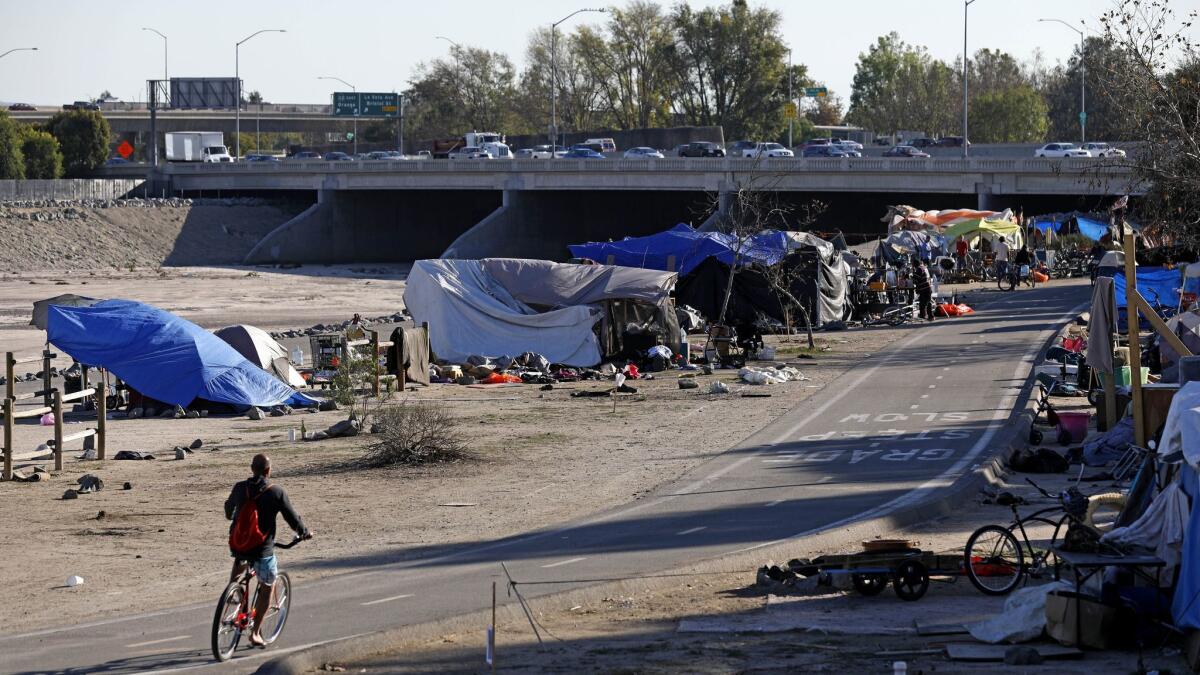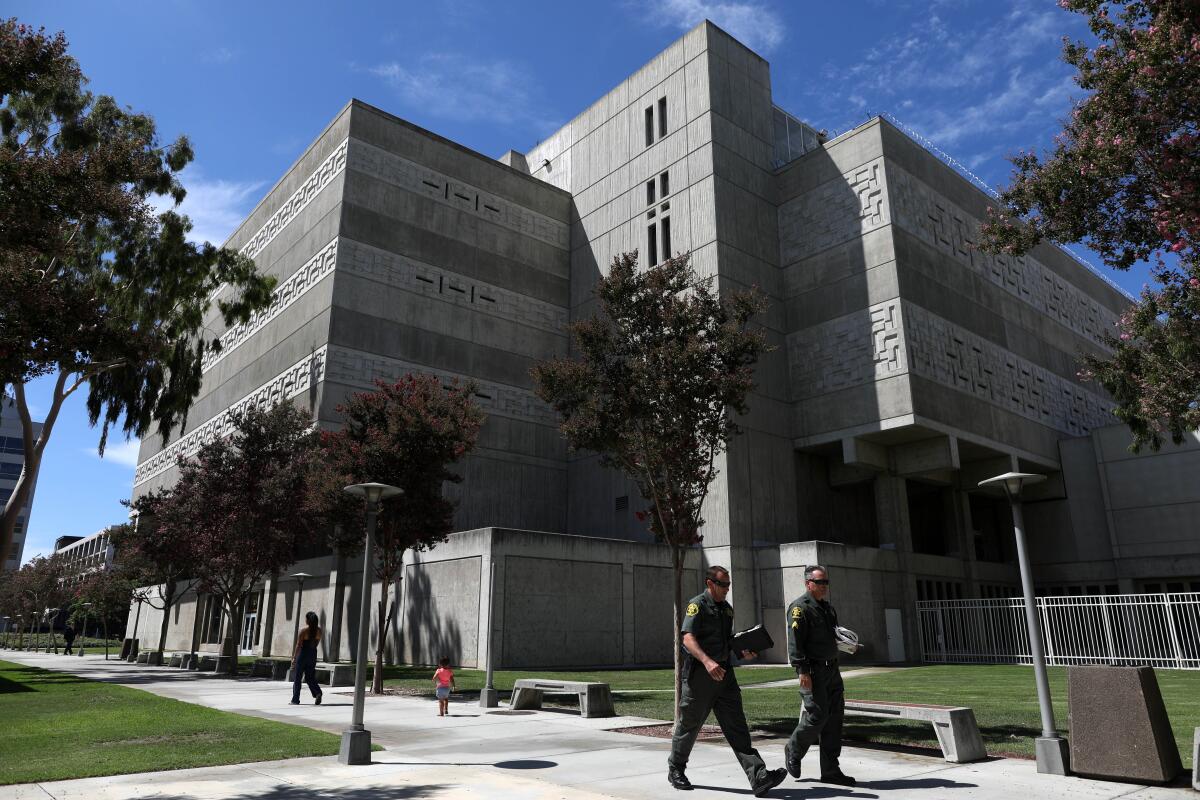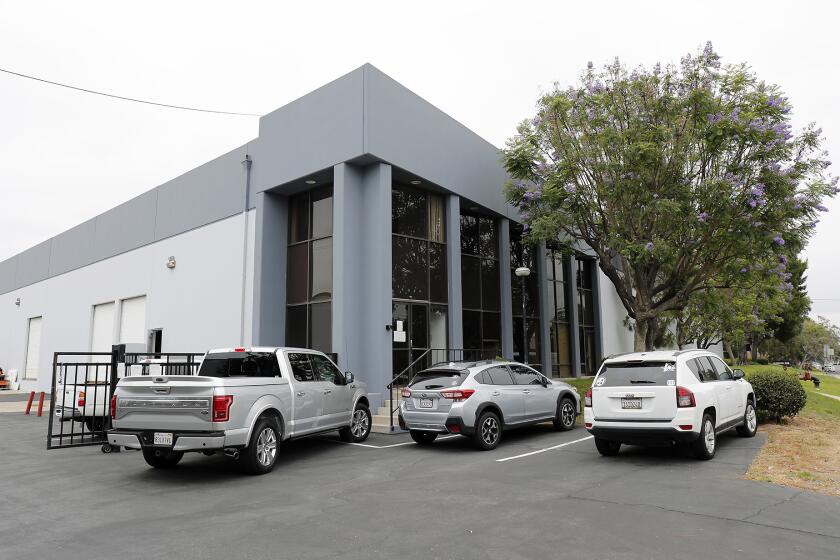Amid an increasing homeless population, Santa Ana fights with Orange County over jail releases
- Share via
Aided by snacks, an iPhone and a friend with a taxi, Vaskin Koshkerian works to be the first stop for newly released jail inmates in Orange County.
He’s parked his RV outside the Central Jail Complex most nights a week for several years, helping thousands of people released onto the streets of Santa Ana. Some need only a quick call to a roommate or a cup of coffee; others have nothing but jail clothes and no way to get back to the park where they usually sleep.
Lately, that’s given Koshkerian a front-row view of the human consequences behind Orange County’s legal fight over homelessness, as the city of Santa Ana accuses the county of Orange of unfairly burdening it with unhoused people from outside the city.
“The city and the county fighting? The poor people are getting screwed,” Koshkerian, a volunteer with the homeless advocacy group Micah’s Way, said while on duty one recent November night. “Let’s figure out how to help the people instead of screwing the people.”
The current battle is part of a wider court saga that began in early 2018 with a 1,500-person homeless camp along the river near Angel Stadium of Anaheim. U.S. District Judge David O. Carter oversaw the disbursement of the camp as part of a lawsuit that’s led to new shelters and homeless services throughout the county, and the judge continues to monitor service expansions through eight settlements with the county and 17 cities.
Carter’s efforts are receiving heightened attention as he presides over a similar lawsuit against the city and county of Los Angeles, and politicians have cited his success in Orange County while advocating for a similar approach in L.A.
But the ongoing legal fight that’s centered across the street from Koshkerian’s RV shows the situation in Orange County is still rife with conflict, and it highlights a persistent debate over what to do with a growing homeless population and how the county’s 34 cities should or shouldn’t cooperate. It’s already changed jail operations, with the sheriff’s department halting most pre-dawn releases.
At its core, the fight is about Santa Ana’s longstanding complaint that the city shoulders too much of the county’s homeless crisis. The jail is in the middle of it, with the city blaming the county for releasing people with no way to get back to the cities where they were picked up. Attorneys in October said the county’s practice “until recently” was to release inmates at midnight “when transportation options were scarce and service providers were closed, rather than during daytime hours.”
“This practice no doubt further increased the likelihood that releases would remain on the streets of Santa Ana rather than returning to the cities in which they were previously living,” according to the lawsuit.
Orange County Sheriff’s Sgt. Dennis Breckner told TimesOC the jail started in January releasing most inmates at 7 a.m. “or later so that services are more readily available.” He said he and his colleagues work with county behavioral health specialists and community groups “to make services available in the jail lobby which can provide post-custody treatment.”
“We also now provide released inmates with necessary medications post-release, some of which is designed to help fight opioid addiction,” Breckner said in an email. “All of this is designed to increase the health, safety and well-being of those released.”
But the dispute goes beyond the jail: Santa Ana attorneys said in an Aug. 31 filing that the county’s pandemic-related reduction of shelter space and heightening of shelter admissions standards “has exasperated the influx … and shone an even brighter light on the inequities arising from the county’s practices.”
A telephone vendor found to have recorded thousands of calls between Orange County inmates and their attorneys may have continued to record confidential calls even after the company said it was no longer doing so, according to a motion filed by Assistant Public Defender Scott Sanders.
The county also “has caved to pressure from wealthier and whiter communities,” Santa Ana attorneys argue, by rejecting shelters in Irvine, Huntington Beach and Laguna Niguel in 2018 and instead authorizing a 425-bed shelter in Santa Ana.
The county’s homeless population increased 43% between 2017 and 2019, or 4,792 to 6,860, with Santa Ana’s share jumping to 26% from 20%.
Attorney Brooke Weitzman said the problems highlight the consequences of disbursing the Anaheim river encampment instead of focusing on bringing services to those living there and trying to eventually get them into housing.
Weitzman and attorney Carol Sobel sued to stop the closure of the Anaheim riverbed encampment in 2018, but it eventually closed under Carter’s supervision, with approximately 700 temporarily moving into motels paid for by the county. But housing wasn’t in place for everyone when the motel stays ended, so many people are back living outside but with no centralized location, which Weitzman said has complicated efforts to help them.
“There are a lot more people from the riverbed in housing than there would have been if they kept doing nothing, but there also are a lot more people scattered around and still homeless,” said Weitzman, who works with Koshkerian on outreach and information.
The riverbed lawsuit settlements detail the shelter facilities each settling city is to build to allow for enforcement of anti-camping ordinances under the 2018 U.S. 9th Circuit Court of Appeal ruling in Martin v. Boise, which says people can’t be cited for sleeping outside if no alternative shelter is offered.

Santa Ana opened a 200-bed shelter in November 2018, and the county is preparing to open the 425-bed shelter in Santa Ana to replace an open-air bus terminal shelter that’s been in place since 2016. Other shelters have opened in Tustin, Anaheim, Placentia and Fullerton, and Buena Park opened one in June through a partnership with 11 nearby cities. Los Angeles County’s Whittier and Bellflower also opened shelters after voluntarily entering the riverbed lawsuit to secure Carter’s guidance through settlements. Costa Mesa opened a 50-bed shelter in 2019 and currently is constructing a 70-bed shelter, in partnership with Newport Beach.
Newport Beach plans to partner with Costa Mesa on the latter’s 70-bed homeless bridge shelter. Under the agreement, Newport Beach will have exclusive access to 20 temporary shelter beds for five years.
Prior to the riverbed lawsuit, there were two shelters in Orange County: one in Laguna Beach and another the county opened in Anaheim in 2016.
The judge is allowing enforcement if cities have beds for 60 percent of the homeless population recorded in the most recent annual count, though he takes a hands-on approach that focuses on individual outreach instead of police involvement. His work has caught on with cities not under his purview, including Huntington Beach, where city officials cited the judge’s 60 percent requirement when authorizing a 174-bed shelter that was to open last week.
But many shelters have reduced capacity because of the pandemic, and Santa Ana says the county’s closure of an armory in Fullerton and its restrictions on the 425-bed shelter have eliminated hundreds of beds. The city’s attorneys also blame the closure of hotels through the statewide Project Roomkey program for putting more people on the street.
All this contributes to what Santa Ana’s lawsuit alleges is the county’s breach of its riverbed settlement, which forbids the county from transporting people from outside Santa Ana and its nearby partner cities into the area for services. The number of unhoused people taken to the jail since the July 2019 settlement range range from 11 in La Habra and 13 in Cypress to 30 in Buena Park and 48 in Brea, according to city records cited by Santa Ana.

Santa Ana initially sued the southern cities of Dana Point, San Clemente and San Juan Capistrano, but attorneys dropped them from the case after each assured them they hadn’t transported any unhoused people to Santa Ana. The sheriff’s department isn’t currently enforcing anti-camping ordinances in those cities or its other south patrol areas because of the lack of shelter.
Still, Breckner said sheriff’s deputies “do make a point to contact individuals experiencing homelessness to offer services that might be available.”
The Navigation Center, which is expected to open by the end of November, will provide up to 174 shelter beds for adults and will also facilitate additional case management and support services.
And anti-camping ordinances aside, unhoused people from all over Orange County often are jailed for other alleged crimes, and the releases Santa Ana is suing over expose what some describe as a troubling lack of post-incarceration services.
“I couldn’t imagine being a girl, coming out here and being released on your own and this place not being here. It’d be pretty scary,” said Harold Walker, 27, as he waited outside Koshkerian’s RV for a ride home on a recent November night. “Just the simple thing of somebody having a phone and a little spot to sit and relax while the people come in and get them, it helps out a lot.”
Walker was among eight or so men released from jail who sought Koshkerian’s help between 9 p.m. and about 11 p.m. that night. He’s not homeless, but others were, including 43-year-old Matthew Jacobs, who said a bus pass was his only way back to a tent where he sleeps in a railroad area in the city of Orange. Koshkerian has bus passes to give and a taxi driver who can help, but he said he sees some people who stay in Santa Ana rather than attempt to get back to wherever they were picked up.
“It happens all the time,” he said.
Meanwhile, attorneys for the city and county were in Carter’s courtroom Nov. 16, and they’re meeting with Carter’s friend, professional mediator and retired judge Jim Smith, to hatch a possible solution before the next hearing on Jan. 13. That’s after Carter warned he’s skeptical of Santa Ana’s claims and noted the city’s historical support of being the center of Orange County government.
Carter said he believes the covert transporting of homeless people into Santa Ana has largely stopped after his firm stance against it in previous court proceedings, which have included him threatening to involve the U.S. Attorney’s Office for possible criminal charges against cities that leave homeless people in Santa Ana.
“What maybe has changed in the last five or 10 years is the onslaught of homelessness,” the judge said. “I think Santa Ana’s here crying out for help.”
The writer is a contributor to TimesOC.
All the latest on Orange County from Orange County.
Get our free TimesOC newsletter.
You may occasionally receive promotional content from the Daily Pilot.





